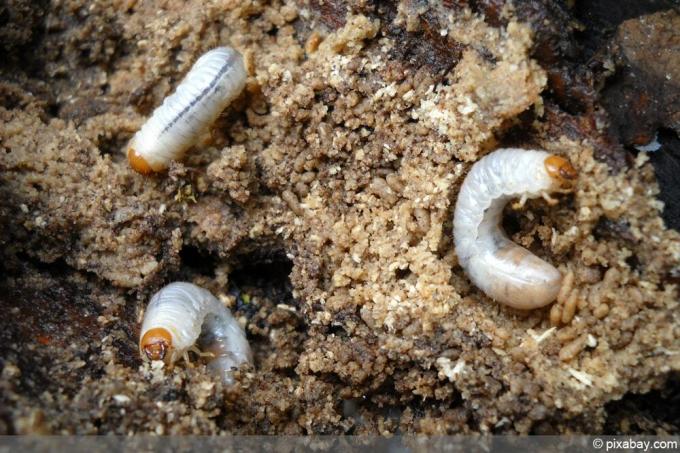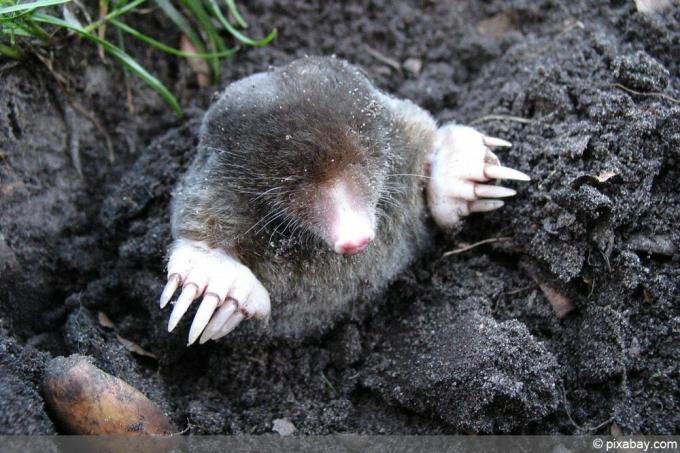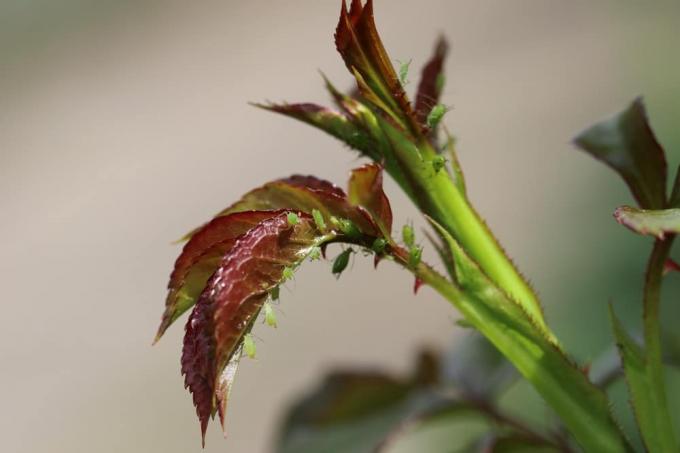

Table of contents
- Happen
- Increased appearance
- habitats
- Recognize
- life cycle
- Prevent
- Fight
- 4 natural predators
In the merry month of May, when the warm rays of sunshine lure into the garden and the plants begin to grow and bloom, it is buzzing and humming, especially in the evening hours. Cockchafers eat the young green from the trees - and lay their eggs in the ground, from which the grubs later hatch. In large occurrences, these damage the plant roots and must be combated.
Happen
The cockchafer (Melolontha) has become rare. The stories of our grandparents, how they collected the pretty brown bugs in boxes after school in the afternoons and sometimes, for example during times of need during the world wars, also ate, we only know later generations from stories. Nowadays in some regions of Germany one hardly sees a cockchafer, in others it is developed the insect, which belongs to the scarab beetle family (Scarabaeidae), is once again a threat to forests and gardens.
Increased appearance
In the 1950s and 60s massively by pesticides such as DDT - which are now banned for good reasons - May beetles that have been fought and almost eradicated have been increasing for several years, primarily in south-west Germany on. Here they are mainly found in beech and oak forests as well as in larger orchards, because Cockchafers prefer the young green of deciduous trees - and of course they often lay theirs near them eggs off.
habitats
While the adult animals fly around between trees and bushes and eat them bare when they appear in large numbers, their larvae live in the ground for up to four years. The thick, white maggots that look like thrive best in loose, humus-rich and loamy soil, while they are rarely found in sandy, dry and lean as well as in swampy subsoils are. Scientists distinguish three different types of cockchafer that claim similar habitats:
- field cockchafer(Melolontha melolontha): also common may beetle, prefers open and unwooded habitats, often on fields, in gardens and on meadows
- wood cockchafer(Melolontha hippocastani): preferably in deciduous forests with many oak, beech and maple trees, rarely also in coniferous forests
- Melolontha pectoralis: very rare in Germany and limited to the southwest, prefers warm and rather dry habitats
Recognize

Adult cockchafers quickly catch the eye, especially when they appear in large numbers:
- up to three centimeters long
- have fan-like antennae on the sides of the head
- brown wing shield
The larvae known as grubs, on the other hand, live in the ground and are often only discovered through soil cultivation measures such as digging. You can recognize them by these characteristics:
- resemble thick, white maggots
- often a thickened, blackish rump
- a brown head
- three pairs of legs at the front of the body
Tip:
Unlike cockchafers, rose chafers are quite useful animals in the garden, although their grubs look very similar to those of the cockchafer. But you can tell them apart with a test: lay the larvae on a flat surface. Rose beetle larvae stretch out and crawl away lying on their backs, while cockchafer larvae curl up and just lie there.
life cycle
The life of an adult may beetle lasts only a short four to six weeks, during which the males die immediately after mating with the females. The females are typically responsible for eating the trees bare, because they ensure that their eggs are ready for laying by so-called "ripe eating". Depending on the species, the females lay their eggs either near trees and larger shrubs or on lawns, flower beds and borders as well as meadows directly in the ground.
They dig holes in the ground to lay their eggs and then die. The grubs that hatch from this live between three and five years in the ground, preferably feeding on plant roots and then digging out after pupating. Adult animals fly mainly between April and May, occasionally also at the beginning of June. Later-flying animals are the similar-looking but smaller June beetles.
Tip:
May beetles appear more frequently in cycles. About every fourth year is a "May beetle year", which can be explained by the life cycle of the animals. Due to their increased occurrence, which used to be massive, the beetles make it difficult for their predators: they could ultimately not all of the individuals in a swarm are consumed, so that there are always enough beetles left over for reproduction.
Prevent
Anyone who is familiar with the life cycles and ways of the animals can roughly estimate when a "cockchafer year" can occur again. The grubs pupate in one of these in order to lay masses of eggs during the flight season in April and May. You can make this project difficult for the animals through various methods:
- Insect protection nets: close-meshed nets prevent flight, oviposition and fertilization of these
- To plan: Cover lawns with tarpaulins in the evening hours
- Light: Keep the garden dark during flight, may beetles are attracted to light sources
- Planting: plant plenty of garlic, delphiniums and geraniums in the garden
You can selectively place the three plant species mentioned in all beds and borders if you have had problems with grubs or grubs in previous years. had cockchafers. The animals do not like garlic because of the smell and instinctively avoid areas planted with the Allium plant to lay their eggs. The roots of delphiniums and geraniums, on the other hand, are readily eaten by grubs, but are deadly poisonous to them.
Fight
When the lawn turns yellow for no apparent reason, shrubs and trees die for no apparent reason and if your garden plants seem to have a problem at all, then there may be grubs behind. You can discover these by digging up the ground at suspected locations. If too many of the animals appear, it is high time for effective countermeasures.
collect

Go into the garden immediately after a heavy downpour and simply collect the grubs. The animals come to the top like earthworms, otherwise they would drown. Then bring them into nature and release them there. Incidentally, you can simulate heavy rain and thus the emergence of the larvae by watering the relevant garden areas heavily.
tillage
Even during the annual digging in spring, numerous grubs can be collected before pupation. You should regularly chop through borders and perennial beds and scarify lawns. This disturbs the larvae and they often die.
Tip:
In the garden, grubs prefer to be near the compost or manure heap. If you dig in root guards and deep lawn curbs in these areas, then the animals will not spread into other garden areas.
application of nematodes
Tiny roundworms, so-called nematodes, have proven to be a useful biological control measure. You can buy these in garden shops and spread them out in the garden with irrigation water. The nematodes kill the grubs, but not only them. Other insect larvae, for example beneficial insects, are also affected.
Insecticides and other chemical agents
On the other hand, you should be careful with insecticides and only use them when nothing else works. "EngerlingFrei" and similarly named agents not only kill the larvae of the cockchafer, but also important beneficial insects. In addition, the chemical substances have other undesirable effects on the flora and fauna in the garden.
Tip:
Instead, set a biological trap for the cockchafer: In the spring, dig a bucket filled with horse manure and compost up to the brim. The female beetles are attracted by the odor emitted and prefer to lay their eggs in this trap.
4 natural predators
However, cockchafers and especially their grubs are not only a nuisance, but also protein-rich and therefore welcome food for many animals. Make your garden animal-friendly, then birds and hedgehogs prefer to settle here and not only keep May beetle larvae but also many other pests at bay.
birds
Blackbirds in particular like to eat the fat grubs, as do sparrows, tits and other songbirds. Put up birdhouses in the garden, plant dense hedges and shrubs: Then the feathered fellows will quickly feel at home with you. Feeding them in winter also attracts many birds.
Hedgehog
Hedgehogs not only like to eat cockchafer larvae, but also slugs and other unwanted garden dwellers. Set up hedgehog houses in sheltered places, offer dense hedges and, in autumn, larger piles of leaves and brushwood as hiding places.
moles

For their part, moles are not particularly popular in the garden because they don't care about the Planting as well as on the beautiful lawns dig everywhere and the characteristic heaps raise. But what hardly any gardener knows: the black fellows are annoying, but very useful when they are It is about grubs and other voracious pests - for example the vine weevil - to get rid of. In addition, with their busy digging activity, they ensure thorough mixing of the soil and thus an increase in soil quality.
shrews
The cute little animals may look like mice, but they aren't. In contrast to the annoying rodents, they belong to the insectivores and feed primarily on grubs and other insect larvae. You can easily recognize shrews by their long, pointed snouts. They have high food requirements and are good at keeping the larval population in the garden in check.
 garden editorial
garden editorial I write about everything that interests me in my garden.
Learn more about pests

Identifying wood pests: overview
In nature, insects that break down wood make a valuable contribution. If the wood is a roof truss, for example, the insect becomes a pest that must be combated in order to avoid expensive damage.

Mole Cricket: Should You Fight Them? | Were in the garden
The mole cricket, or Werre, as it is also known, often lives unnoticed in gardens and parks. Because the insect with the scientific name Gryllotalpa gryllotalpa spends a large part of its life underground. Fighting them is only necessary in a few cases.

Combat Whitefly | 11 home remedies for whiteflies
The whitefly is a tiny creature whose presence on our plants can have unpleasant effects. If a few specimens come across a healthy garden, there is hardly anything to fear. If the flies are there in droves, proven home remedies must be used immediately.

Ant remedy | 13 natural remedies against ants
Ants are more than annoying bugs. In nature, they contribute to the preservation of the forest and keep pests away. If they undermine the terrace slabs in the garden or penetrate into the house, they must be fought. Which natural remedies are effective?

How does ant spray work? Is it toxic to humans?
Many people use special sprays from well-known manufacturers when fighting ants. Their effect is indeed efficient. However, these synthetic agents not only have advantages but also disadvantages in terms of environmental impact and health. It is therefore advisable to resort to natural means.

13 home remedies against aphids: coffee grounds, garlic, tea tree oil & Co
There are a variety of household remedies that will get rid of aphids. Many products are available in every household. A watery solution can be prepared in just a few steps and sprayed directly onto the plant.
